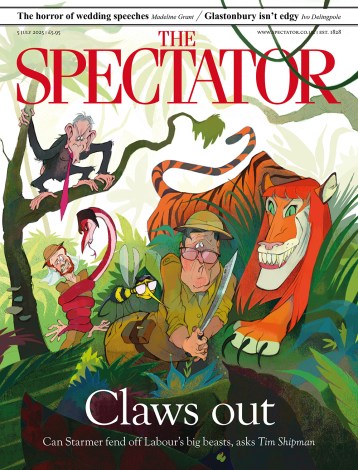One wintry day during lockdown, the parliamentary political adviser Chloe Dalton discovered a new-born leveret on the track by her converted barn. It was only as long as her palm’s width, with a white star shape on its forehead. Ambivalent about interfering, she nonetheless gave it houseroom, despite being warned that brown hares can never really be domesticated. This book, her first, is the chronicle of how the animal changed her life.
Soon her home has two leverets lolling on the sofa and gnawing her curtains
If, like me, you have become leery of the subgenre (even though this example comes larded with plaudits from Angelina Jolie and Michael Morpurgo) and feel that such writing peaked with Virgil’s apocryphal elegy to his pet housefly, you will find Raising Hare notably different. For a start, the hare of the title (never named nor properly tamed) is no pet, and the author is an unlikely candidate for such experiences, being a committedly urban, globetrotting professional who has not cared for an animal since the age of eight and seems hitherto largely heedless of the natural world.
Not everyone likes hares. Unlike rabbits, their fellow lagomorphs, they are not quite cute, and have historically been regarded as uncanny. They are fabulous beasts, with magical and shamanistic associations, not simply as witches’ familiars. They were sacred to the Teutonic dawn goddess Eostre, for instance – and became the Easter Bunny. They can leap six feet, accelerate for their body length faster than a cheetah, and, when wounded, shriek like a mandrake. After reading this book, you might want to think twice about ordering that pappardelle alla lepre.
Aware from the outset of the tricky balance between sanctuary and independence for her ‘little one’, but uncertain as to anything else about ‘harekind’ (even the vet has minimal experience), Dalton initially bottle-feeds it, then gleans a clue from the moody poet William Cowper, who recommended oats: one of his three hares lived until the age of 11, though she still bit him. They are scrupulously clean, however, and engage in refection – secondary mastication of their softest droppings, or crotels. Even so, as the months go by, there are certainly hare-raising challenges. Dalton adapts her own domestic behaviour (no perfume, no evening telly, even the news), and gradually the hare comes to trust her. In turn, she responds to its composure – and, yes, its ‘innocence’.
One of the features of this account is the refraining from anthropomorphic indulgence, and the absence of nambi-bambification. The hare does not become some daemon or surrogate child. ‘It was always going to leave, as I was,’ remains the attitude. Still, Dalton understandably waxes protective, and is alarmed that most leporine literature concerns the pursuit, or cooking, of the hare, once reckoned a prime beast of venery. She quotes from hunting treatises, and William Somerville’s dismal 1753 poem ‘The Chase’ (he was the subject of one of Johnson’s most caustic ‘Lives’ – ‘he writes very well for a gentleman’) and draws widely on bestiaries, herbals and folklore. However, the useful bibliography omits that nice monograph The Language of Sport (1939) by Major C.E. Hare.
In steady, elegant, whimsy-free prose, Dalton documents minute observations of her daily coexistence with the leveret – its soft huffing utterances (‘chit-chit’), its shed whiskers (‘like miniature porcupine quills’), its expressive ears (Ted Hughes once memorably described them as ‘hearing tomorrow’s weather’) and the seasonal changes in pelage, crucial camouflage for a creature that does not resort to burrows. ‘The house smelled faintly like digestive biscuits’ – the scent of hares. Dalton overturns several misconceptions about the animals: they are neither solitary nor timid, and are highly inquisitive. In Part Two, the leveret reaches adulthood, and the ménage is further transformed.
Folk used to believe that hares were hermaphroditic – in certain depictions of the Ark they appear singly – and they later became a byword for sexual promiscuity, one name even being ‘bawd’. Unusually, they can achieve ‘superfetation’, the female carrying two litters simultaneously. When the author returns from a trip to the Middle East she realises that ‘her’ hare has conceived leverets in the wild, and soon her home has two juveniles lolling on the sofa, gnawing the curtains and disturbing her rest. This mischief is never mawkish – and she acknowledges that the rare idyll cannot last.
As her perspective on our natural world, and the whole idea of ‘home range’, is modified, she passes on much curious information: how hares on Vesuvius seek out goat’s rue; how yarrow was used to treat piles, and wild oats to lure trout (a new one on me). But also, in the rousing penultimate chapter entitled ‘Blood in the Harvest’, where she sees the bloody aftermath of a mechanically retrieved potato crop, there is a reasoned plea for doing things differently in the countryside while there’s still time.
Dalton is much too savvy to let her convictions sound shrill, and one great advantage of the book is its admiring focus on her subject, concluding: ‘She did not change; I did.’ This is indeed a remarkable debut.







Comments